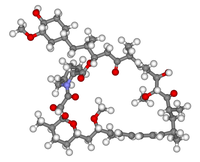
Photo from wikipedia
Simple Summary Proteasome inhibitors are currently used in the treatment of certain blood cancers, and clinical trials to treat solid tumors, including liver cancer, have also been conducted. However, different… Click to show full abstract
Simple Summary Proteasome inhibitors are currently used in the treatment of certain blood cancers, and clinical trials to treat solid tumors, including liver cancer, have also been conducted. However, different malignancies are not equally susceptible to proteasome inhibitors, and resistance to the drug may develop during the therapy. Here, we characterize the molecular mechanisms underlying the resilience of liver cancer cells to the proteasome inhibitor bortezomib. The results demonstrate that the activity of the eIF2α–ATF4 stress response pathway affects the viability of cells treated with bortezomib. We found that the pseudokinase TRIB3, an endogenous regulator of ATF4 and a gene highly expressed in liver cancer, resides predominantly at the same chromatin sites as ATF4 and constrains ATF4 activity. The survival of bortezomib-exposed hepatoma cells proved sensitive to TRIB3 overexpression and inactivation. Thus, TRIB3 is a novel factor contributing to bortezomib resistance of liver cancer cells. Abstract The proteasome is an appealing target for anticancer therapy and the proteasome inhibitor bortezomib has been approved for the treatment of several types of malignancies. However, the molecular mechanisms underlying cancer cell resistance to bortezomib remain poorly understood. In the current article, we investigate how modulation of the eIF2α–ATF4 stress pathway affects hepatoma cell response to bortezomib. Transcriptome profiling revealed that many ATF4 transcriptional target genes are among the most upregulated genes in bortezomib-treated HepG2 human hepatoma cells. While pharmacological enhancement of the eIF2α–ATF4 pathway activity results in the elevation of the activities of all branches of the unfolded protein response (UPR) and sensitizes cells to bortezomib toxicity, the suppression of ATF4 induction delays bortezomib-induced cell death. The pseudokinase TRIB3, an inhibitor of ATF4, is expressed at a high basal level in hepatoma cells and is strongly upregulated in response to bortezomib. To map genome-wide chromatin binding loci of TRIB3 protein, we fused a Flag tag to endogenous TRIB3 in HepG2 cells and performed ChIP-Seq. The results demonstrate that TRIB3 predominantly colocalizes with ATF4 on chromatin and binds to genomic regions containing the C/EBP–ATF motif. Bortezomib treatment leads to a robust enrichment of TRIB3 binding near genes induced by bortezomib and involved in the ER stress response and cell death. Disruption of TRIB3 increases C/EBP–ATF-driven transcription, augments ER stress and cell death upon exposure to bortezomib, while TRIB3 overexpression enhances cell survival. Thus, TRIB3, colocalizing with ATF4 and limiting its transcriptional activity, functions as a factor increasing resistance to bortezomib, while pharmacological over-activation of eIF2α–ATF4 can overcome the endogenous restraint mechanisms and sensitize cells to bortezomib.
Journal Title: Cancers
Year Published: 2021
Link to full text (if available)
Share on Social Media: Sign Up to like & get
recommendations!